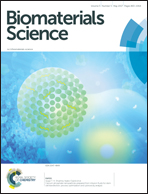Mustard-inspired delivery shuttle for enhanced blood–brain barrier penetration and effective drug delivery in glioma therapy†
Abstract
Effective penetration through the blood–brain barrier (BBB) remains a challenge for the treatment of many brain diseases. In this study, a small molecule, sinapic acid (SA), extracted from mustard, was selected as a novel bioinspired BBB-permeable ligand for efficient drug delivery in glioma treatment. SA was conjugated on the surface of zwitterionic polymer poly(2-methacryloyloxyethyl phosphorylcholine) (PMPC)-encapsulated bovine serum albumin (BSA)-based nanoparticles, yielding nBSA-SA. The PMPC shell serves as a protective layer to prolong the in vivo blood circulation time with a better chance to cross the BBB. Furthermore, temozolomide (TMZ), which can be loaded onto the nanoparticles via electrostatic interactions with acrylic acid (AA) to generate AA-nBSA-SA-TMZ, was applied as an excellent chemotherapeutic drug for glioma therapy. The obtained nanoparticles with a distinct size show great BBB permeability. Through the mechanism study, it was found that the cell internalization of the SA-conjugated nanoparticles is an energy-dependent process with only transient disruption of the BBB. The biological evaluation results unambiguously suggest that drug-loaded nanoparticles can lead to strong apoptosis on the tumor site and increase the median survival time of glioma-bearing mice. Overall, this novel BBB-permeable ligand SA paves the way for the delivery of cargo into the brain and provides a powerful nanoplatform for glioma therapy via intravenous administration.



 Please wait while we load your content...
Please wait while we load your content...